Adaptive Research Unit
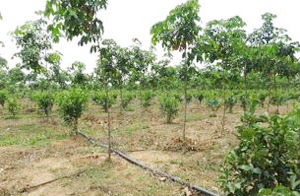
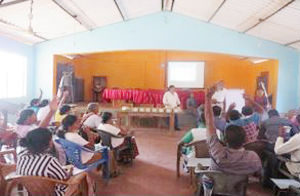
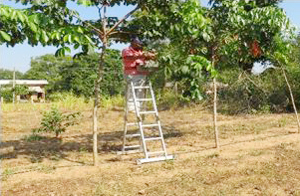
This unit uses both ”Top-down” and “Bottom-up” approaches to refine the technologies available in the large-scale plantation sector in favour of smallholders and plan the future research to cater the smallholder requirements, respectively. Among the research activities of the unit, developing rubber based farming systems particularly to the non-traditional areas whilst characterizing the socio economic conditions of smallholdings is in top priority.
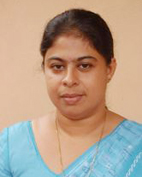
Principal Research Officer
Mrs E S Munasinghe, BSc Agric (SL), PhD (SL)
enokamunasinghe[at]yahoo.com
Obtained the basic degree in BSc Agriculture from the University of Peradeniya and joined RRISL as a Research Officer in 2005. Has completed the PhD on Environmental Economics at the University of Sri Jayewardenepura in 2009 and working as a Principal Research Officer in the Adaptive Research Unit. Currently engage in adaptive research activities and carbon market. Contributed to the rubber industry by developing models for assessment of timber, biomass and carbon in rubber plantations, identifying socio-economic factors affecting the profitability of rubber based intercropping systems, assessing financial and economic viability of rubber cultivation under different cultivation scenarios, shortening the lifespan of rubber for high returns, establishing rubber in Eastern and Northern regions of the country by developing agronomic protocols, characterizing the livelihood and environmental impacts. Have published over 60 scientific publications and was honored by National Awards for Excellence in Agricultural Research in Sri Lanka 2014, National Research Council Merit Award for Scientific Publication in 2014 and Presidential Research Award in 2004.
Current Research interests
- Rubber cultivation to non-traditional areas
- Socioeconomics of rubber cultivation
- Carbon trading
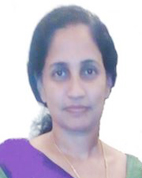
Research Officer
Mrs B M D C Balasooriya, BSc Agric (SL)
dcbalasooriya[at]yahoo.com
Ms B M D C Balasooriya graduated from the Faculty of Agriculture, University of Peradeniya and joined to the Rubber Research Institute of Sri Lanka (RRISL) as a Research Officer in 2005. Since 2017, she is continuing her work attached to the Polgahawela sub-station of RRISL. Currently, she is engaged in research on socio-economics, on farm experimentation, adaptability trials and farming system research in smallholder rubber sector. While engaged in the duties at RRISL she is currently pursuing her PhD in the Wayamba University of Sri Lanka (WUSL).
Current Research interests
- Agronomy
- Socioeconomics and Adaptive research
- Developed suitable protocol to cultivate the rubber in the Intermediate Zone of Eastern Province of Sri Lanka. Latex harvesting in smallholder fields were commenced in Padiyathalawa and Mahaoya Divisional Secretaries divisions assuring permanent income to the peasant community.
- Quantified the livelihood capital improvements in rubber growing community of the Eastern Province.
- Issued an interim recommendation to cultivate rubber in the Dry Zone of Eastern and Northern Provinces of Sri Lanka. Latex harvesting was inaugurated in the firstly planted smallholder rubber field in Vavuniya District.
- Identified agronomic, socioeconomic and cultural limitations for proper adoption of rubber cultivation in Northern Province.
- Identified the feasibility of cultivating rubber in Thalawa, Galenbindunuwewa and Kahatagasdigiliya Divisional Secretaries divisions of Anuradhapura district of North-Central Province.
- Identified the possibility of shortening the lifespan of rubber cultivation to obtain high returns under Sri Lankan conditions.
- Identified the adoption and awareness level of key agronomic recommendations by the rubber smallholders in Kegalle district.
- Developed carbon trading project with the objective of obtaining Voluntary Carbon Standards (VCS) for new rubber cultivations scheduled to be planted in Uva and Eastern provinces.
- Estimated carbon footprint for rubber cultivation.
- Development of suitable protocols to cultivate rubber in Dry Zone
- Assessments on socioeconomic impact of rubber cultivation in Eastern Province
- Identification of agronomic and socio-economic feasibility for rubber cultivation in new areas
- Identification of suitable farming models for new rubber growing areas
- Testing the adaptability of new animal repellent under smallholder conditions
- Identifying on-farm behaviour of smallholder rubber farmers in traditional rubber growing areas
- Bee keeping in rubber plantations
- Assessment of farmer perceptions and economics of technology adoption in the smallholder rubber sector
- Identification of gender issues among plantation workers
- Assessment on education level and child protection among plantation community children
- Problems and perspectives of younger generation in plantation communities
- Development of carbon trading project to obtain Voluntary Carbon Standards (VCS) for new rubber cultivations in Uva and Eastern provinces
- Estimating carbon footprint of rubber related organizations
-
Dr. (Mrs) E S Munasinghe
Presidential Awards for Research – 2004
National Award for the Excellence in Agricultural Research - 2014
National Research Council Merit Award for Scientific Publication -2014
- Providing technical assistance to establish rubber in non-traditional areas
- Supervising postgraduate and undergraduate students
- Training of students from technical colleges and various training institutions
- Munasinghe, E. S., Rodrigo, V. H. L., Jayathilake, P. M. M., Piyasena N. M. and Iqbal, S. M. M. (2019). Livelihood capital improvements in the rubber growing community of the Eastern Province of Sri Lanka Proceedings of the Seventh Symposium on Plantation Crop Research, Sri Lanka. 123-134.
- Balasooriya, B. M. D. C., Edirisinghe, J. C., Seneviratne, P. and Piyasena, N. M. (2019). Status of Farmer Awareness and Adoption of Recommended Technologies in the Smallholder Rubber Sector in Kegalle District. Proceedings of the Wayamba University Research Congress. Senate Research and Higher Degrees Committee, Wayamba University of Sri Lanka. 95 -96.
- Balasooriya, B. M. D. C., Edirisinghe, J. C. and Seneviratne, P. (2019). Nexus between Awareness of Recommendations and Income from Rubber Cultivation: A Structural Equation Model [SEM]. Sri Lankan Journal of Economic Research, 6(2).
- Munasinghe, E. S. and Rodrigo, V. H. L. (2018). Lifespan of rubber cultivation can be shortened for high returns: a financial assessment on simulated conditions in Sri Lanka. Experimental Agriculture. 54(3), pp 323-335.
- Munasinghe, E. S., Rodrigo, V. H. L., Jayathilake, P. M. M and Piyasena, N. M. (2018). Assessing the impact of rubber cultivation in non traditional areas for rural livelihood development in the Eastern province of Sri Lanka. Proceedings of the Second International Agricultural Research Symposium 2018. Sri Lanka Council for Agricultural Research Policy. 126.
- Hettiarachchi, H.A.I.U., Balasooriya, B. M. D. C. and Edirisinghe J.C. (2018) Scale Efficiency in Smallholder Rubber Sector in Kegalle District: A Data Envelopment Analysis. Proceedings of the 17th Agricultural Research Symposium. Faculty of Agriculture and Plantation Management, Wayamba University of Sri Lanka. 330 -334.
- B. M. D. C., Edirisinghe, J. C. and Seneviratne, P. (2018). Impact of perception, awareness and adoption of technologies in reducing production variability in smallholder rubber cultivations in Kurunegala district. Proceedings of the Wayamba University Research Congress, Wayamba University of Sri Lanka. July 56 -57.
- Premarathna, G.N.S., Munasinghe, E.S., Rodrigo, V.H.L., Ginigaddara, G.A.S. and Bandara, A.M.K.R. (2017). Ground Level Impediments for Proper Adoption of Rubber Cultivation in Northern Province of Sri Lanka. Journal of the Rubber Research Institute of Sri Lanka. 97.
- Premarathna, G. N. S., Ginigaddara, G. A. S., Munasinghe, E. S., Bandara, A. M. K. R. and Rodrigo, V. H. L. (2017). Socio-economic, cultural and agronomic limitations for adaptation of rubber cultivation in Northern province of Sri Lanka. Proceedings of 9th Annual Research Symposium, Faculty of Agriculture, Rajarata University of Sri Lanka, Rajarata University of Sri Lanka. 12.
- Iqbal, S. M. M., Rodrigo, V. H. L., Munasinghe, E. S., Balasooriya B. M. D. C., Kudaligama, K. V. V. S., Jayathilake, P. M. M. and Randunu, R. P. S. (2016). Growth performance of young rubber (Hevea brasiliensis) in the Dry Zone of Sri Lanka; an investigation in Vavuniya District. Proceedings of the Sixth Symposium on Plantation Crop Research, Sri Lanka. 101-111.
- Rupasinghe, P. V. S., Munasinghe, E. and Withanage, N. S., (2016). Effect of anti-transpirant in sustaining rubber leaf physiology under dry climatic conditions. Proceedings of the Third International Conference of Agricultural Sciences of Sabaragamuwa University of Sri Lanka, Sabaragamuwa University of Sri Lanka. 116-119.
- Munasinghe, E. S. and Rodrigo, V. H. L. (2016). Effect of land productivity on the economic lifespan of rubber plantations; a situation analysis in Sri Lanka. Proceedings of the International Rubber Conference 2016, International Rubber Research and Development Board, Siem Reap, Cambodia. 21st – 22nd December 2016. 136-142.
- Rodrigo, V. H. L. and Munasinghe, E. S. (2016). Competitive crops for rubber plantations; a comparative financial analysis under Sri Lankan conditions. Proceedings of the International Rubber Conference 2016, International Rubber Research and Development Board, Siem Reap, Cambodia. 21st – 22nd December 2016. 128-135.
- Munasinghe, E. S., Rodrigo, V. H. L., Gunawardena, U. A. D. P. (2015). Biomass from rubber trees for renewable energy: a review of Sri Lankan scenario. Proceedings of the Twentieth International Forestry and Environmental Symposium 2015 of the Department of Forestry and Environmental Science, University of Sri Jayewardenepura, Sri Lanka, 81.
- Kumara, P. R., Munasinghe, E. S., Rodrigo, V. H. L. and Karunaratna, A. S. (2015). Carbon footprint of rubber/sugarcane intercropping system in Sri Lanka; a case study. Fifth International Conference of Sabaragamuwa University of Sri Lanka, Sabaragamuwa University of Sri Lanka. 50-51.
- Munasinghe, E.S., Rodrigo, V.H.L. and Gunawardena, U.A.D.P. (2014). Modus operandi in assessing biomass and carbon in rubber plantations under varying climatic conditions. Experimental Agriculture. 50(1), pp 40-58.
- Rodrigo, V. H. L., Iqbal, S.M.M., Munasinghe, E. S. and Balasooriya, B. M. D. C. (2014). Rubber in East assures the perceived benefits; increased rubber production, amelioration of the climate and improved the rural livelihood. Proceedings of the Fifth Symposium on Plantation Crop Research, Sri Lanka. 219-227.
Services
- Providing technical assistance to establish rubber in non-traditional areas
- Supervising postgraduate and undergraduate students
- Training of students from technical colleges and various training institutions
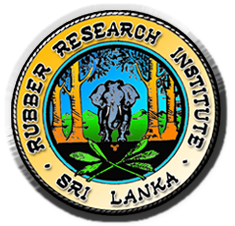




 Call 1919
Call 1919